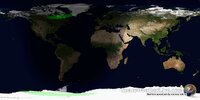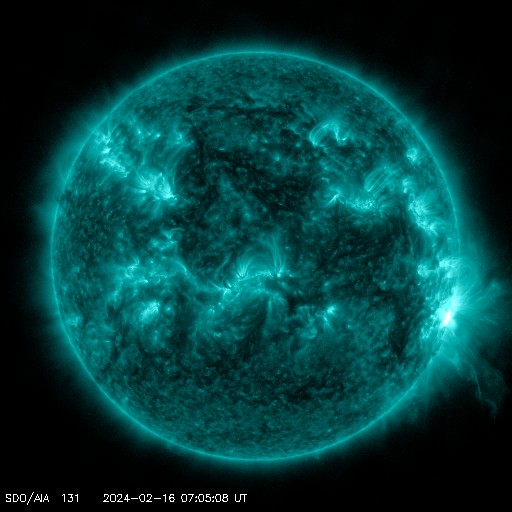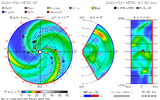SOLAR CYCLE 25 ACTIVITY REPORT FEBRUARY 10_2024

The total number of sunspots has decreased to 105 of which 36 of them are grouped into 8 active regions as follows: AR3571, AR3572, AR3574, AR3576, AR3577, AR3579, AR3580, AR3581

AR3565 & AR3578 are gone
The geomagnetic field has been at quiet levels (Kp1) for the past 24 hours. On February 09 Solar wind speed reached a peak of 506 km/s (Moderately high speed) at 09:06 UTC Total IMF reached 7 nT at 20:53 UTC
Aurora Oval Bz: 3.51 nT North

● Current Conditions at 05:21 UTC on February 10
▪︎ Geospace quiet (Kp 1)
▪Solar wind speed record: 416 km/sec (Elevated speed)
▪︎ density: 7.57 p/cm³ (low density)
▪︎ Interplanetary Magnetic Field (IMF)
Bt: 4 nT
▪︎ X-ray Solar Flare: M3.44 at 03:54 UTC


▪︎ Thermosphere Climate Index
today: Warm
▪︎ Neutron Counts today: -3.3% (Low)
▪︎ Sunspot number: 105 (SN 149 February 08)
▪︎ Spotless Days 2023 total: 0 days (0%)
▪︎There are no significant coronal holes on the Earthside of the sun
.......
SpaceWeatherlive.com
SpaceWeather.com
Solar activity has been at high levels for the past 24 hours. The largest solar event of the period was a X3 event observed at 1314 UTC from Region 3575. See previous post. On the other hand AR3576 produced a M1.2 event observed at 18:00 UTC the flare caused a Minor R1 radio blackout over West Pacific Ocean. In the following image we can also see a Moderate S2 Solar Radiation Storm which caused effects on HF radio through polar regions and satellite operations. (Red and green on polar areas) this was due to the X flare.

The total number of sunspots has decreased to 105 of which 36 of them are grouped into 8 active regions as follows: AR3571, AR3572, AR3574, AR3576, AR3577, AR3579, AR3580, AR3581
AR3565 & AR3578 are gone
NOAA maintains its forecast for the next 24 hours at: 99% chance for C flares, 60% chance for M flares and 25% chance for X flares. This is due to the fact that the colossal sunspot AR3576 continues with a beta-gamma-delta magnetic field that harbors energy for strong X-class solar flares. In the last 24 hours this active region increased its size to 710 MH (yesterday it had an area of 670 MH) however it decreased its number of sunspots to 27 after having recorded 44.
● Auroral Activity
The geomagnetic field has been at quiet levels (Kp1) for the past 24 hours. On February 09 Solar wind speed reached a peak of 506 km/s (Moderately high speed) at 09:06 UTC Total IMF reached 7 nT at 20:53 UTC
Aurora Oval Bz: 3.51 nT North
● Current Conditions at 05:21 UTC on February 10
We see that the solar wind velocity remains at Elevated levels and due to the S2 Solar Radiation Storm the number of protons per cubic centimeter has increased, however the magnetosphere remains undisturbed at Kp1 level.
PROTONS ARE RAINING DOWN ON EARTH: An S2-class radiation storm is underway following today's strong X3.4-class solar flare... Energetic solar protons raining down on Earth's upper atmosphere are causing a polar cap absorption event, interfering with the reception of shortwave radio signals at high latitudes. SpaceWeather.com
The Interplanetary Magnetic Field (IMF) has a low impact (4nT) on the Earth's magnetic field at this time so there is not chance of auroral activity. The last recorded solar flare was a M3.4 at 03:54 on February 10 from a unnumbered region. The flare generated a Minor R1 radio blackout over Australia. The first images of the event show that there was a coronal mass ejection not Earth directed.
▪︎ Geospace quiet (Kp 1)
▪Solar wind speed record: 416 km/sec (Elevated speed)
▪︎ density: 7.57 p/cm³ (low density)
▪︎ Interplanetary Magnetic Field (IMF)
Bt: 4 nT
▪︎ X-ray Solar Flare: M3.44 at 03:54 UTC
▪︎ Thermosphere Climate Index
today: Warm
▪︎ Neutron Counts today: -3.3% (Low)
▪︎ Sunspot number: 105 (SN 149 February 08)
▪︎ Spotless Days 2023 total: 0 days (0%)
▪︎There are no significant coronal holes on the Earthside of the sun
.......
SpaceWeatherlive.com
SpaceWeather.com







 :
:


